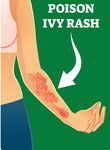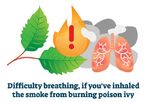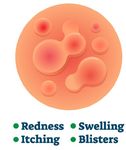Poison Ivy, Oak, & Sumac Fact Sheet
←
→
Page content transcription
If your browser does not render page correctly, please read the page content below
Poison Ivy, Oak, & Sumac
Fact Sheet
HS04-064D (06-21)
E
mployers and employees need to take precautions when
working in and around wooded areas, heavy foliage, and
along riverbanks where poison ivy, oak, and sumac plants
typically grow. According to the American Skin Association,
about 85% of the population are allergic to these poisonous
plants, and about 10% to 15% are highly allergic.1
The sap of poison ivy, oak, and sumac contains a toxin called
urushiol oil. It only takes small amounts of this chemical to
cause itching, a rash, and blisters. The urushiol oil is inside
the plant, so brushing against an intact plant usually does not
cause an allergic reaction. Undamaged plants, however, are
rare.
Urushiol – from the Japanese word urushi meaning lacquer --
sticks to most things, including tools, shoes, clothes, and pets.
Touching the stems, roots, or leaves of damaged plants can
transfer the sticky substance to the skin, creating a reaction
known as contact dermatitis.
Avoiding Exposure
Prevention is the best cure for poison ivy, oak, and sumac.
These steps can help keep employees safe:
• Wear long pants, long sleeves, boots, and gloves for
protection when working in wooded areas, heavy foliage,
and along riverbeds.
• Use barrier skin creams that contain bentoquatam.
Wash off the cream and reapply it twice daily. Consult a
physician before use.
• Rid worksites of poison ivy, oak, and sumac by spraying
the plants with the herbicide, glyphosate, according to
label directions. The best time to apply the herbicide is
May through July, when poison ivy, oak, and sumac are
flowering.
• Avoid burning these plants because urushiol can cause
lung irritation when inhaled.
1
American Skin Association. “Poison
• Cut poisonous vines in trees six inches above ground Ivy, Sumac and Oak.” Webpage.
level. Apply glyphosate to the stump immediately to kill https://www.americanskin.org/
resource/poisonivy.php. Accessed
the roots and prevent sprouting. If resprouting does June 18, 2021.
occur, treat the leaves with glyphosate.Poison Ivy, Oak, and Sumac Myths and Facts
Poison ivy rash is contagious.
Nope. Rubbing the rash does not spread poison ivy to other parts of your
body (or to another person). You spread the rash only if urushiol oil is left
on your hands or another surface.
You can catch poison ivy simply by being near the plants.
Try again. Direct contact with the plants is needed to release urushiol
oil. However, forest fires, direct burning, lawnmowers, and trimmers can
cause the urushiol oil to become airborne.
The saying, “Leaves of three, let them be.”
Not always. While poison ivy and oak have three leaves per cluster, poison
sumac has 7-13 leaves on a branch.
Do not worry about dead plants.
Big mistake. Urushiol oil stays active on any surface, including dead plants,
for up to five years.
Breaking the blisters releases urushiol oil that can spread.
Not true. Wounds, however, can become infected and make the scarring
worse. In extreme cases, excessive fluid may need to be withdrawn by a
doctor.
I have touched poison ivy many times and never had an allergic
reaction. That means I am immune.
Not necessarily true. The more times a person is exposed to urushiol, the
more likely they will get an allergic reaction. Generally, it takes longer for
the rash to show up for the first-time sufferer, usually 7-10 days.
Texas Department of Insurance, Division of Workers’
Compensation www.txsafetyatwork.com
2 HS04-064D (06-21)What to Do If Exposed
Because urushiol can penetrate the skin
within minutes, do not waste time if exposed.
The faster the skin is cleaned, the better the
chance of removing the urushiol before it
penetrates the skin. Cleaning may not stop
the initial outbreak of the rash if more than 10
minutes has passed, but it can help prevent
the rash from spreading.
If exposed to poison ivy, oak, or sumac, stay Treating the Rash
indoors and wear gloves (dispose of after use)
until the following steps are completed:
1.
Cleanse exposed skin with
generous amounts of rubbing
(isopropyl) alcohol.
Do not return to the woods, yard,
or riverbank the same day. Alcohol
removes the skin’s protection along
with the urushiol. Any new contact can
cause the urushiol to penetrate faster. If the exposed area is not cleaned quickly and
2.
thoroughly, or if the skin is sensitive, redness,
Wash cleansed skin with water.
swelling, itching, and blisters may appear
Do not use soap yet.
within 12 to 48 hours. For people with a first-
time exposure, the rash may not appear until
3. Shower with soap and warm 7 to 10 days.
water.
The oozing blisters are not contagious. The
Again, do not use soap before this
blister fluid does not contain urushiol to infect
point. The soap can pick up urushiol
other parts of the person’s body. Nevertheless,
on the skin and move it to new areas.
scratching the blisters with fingernails that
4.
Wear disposable gloves to wipe may carry germs could cause an infection.
off shoes, tools, and anything else
The rash only occurs where urushiol
that came into contact with the
has touched the skin. It does not spread
urushiol.
throughout the body. However, the rash may
First, use alcohol, then water.
seem to spread if it appears over time instead
5.
Wash clothing separately. of all at once. This apparent delayed reaction
Use hot water with detergent. is because the urushiol is absorbed at different
rates in different parts of the body or because
of repeated exposure to contaminated objects
or urushiol trapped under the fingernails.
Consult a physician before using any of the
following remedies for relief of symptoms:
Texas Department of Insurance, Division of Workers’
Compensation www.txsafetyatwork.com
HS04-064D (06-21) 3Itch Relief Signs of an Emergency
The rash, blisters, and itch usually disappear For severe cases, prescription topical
in 14 to 20 days without any treatment. corticosteroid drugs can halt the reaction,
Temporary itch relief may be found by using but only if treatment begins within a few
wet compresses or soaking in cool water. hours of exposure. The American Academy of
Other methods of itch relief include: Dermatology recommends that people who
have had severe reactions before contact a
• oral or topical antihistamines; dermatologist as soon as possible after a new
• over-the-counter topical corticosteroids exposure.
(commonly called hydrocortisones); or In rare cases, persons who are highly allergic to
• topical anesthetics to numb the itchy poison ivy, oak, and sumac may break out in a
rash, such as menthol, benzocaine, and rash and begin to swell in 4 to 12 hours. Then,
pramoxine. their eyes may swell shut, and blisters may
erupt on their skin. In this emergency event,
Treating the Blisters call 911 and get the victim to a hospital as soon
There are several over-the-counter products to as possible.
help dry up oozing blisters including:
• aluminum acetate;
• baking soda;
• oatmeal bath;
• aluminum hydroxide gel;
• calamine;
• kaolin;
• zinc acetate;
• zinc carbonate; and
• zinc oxide.
Texas Department of Insurance, Division of Workers’
Compensation www.txsafetyatwork.com
4 HS04-064D (06-21)www.txsafetyatwork.com
1-800-252-7031, Option 2
The Texas Department of Insurance,
Division of Workers’ Compensation (DWC)-Workplace Safety
P.O. Box 12050
Austin, TX 78711-2050
Disclaimer: Unless otherwise noted, this document was produced by the Texas Department of Insurance, Division of Workers’ Compensation
using information from staff subject specialists, government entities, or other authoritative sources. Information contained in this fact sheet
is considered accurate at the time of publication. For more free publications and other occupational safety and health resources, visit www.
txsafetyatwork.com, call 800-252-7031, option 2, or email resourcecenter@tdi.texas.gov.
Texas Department of Insurance, Division of Workers’
Compensation www.txsafetyatwork.com
HS04-064D (06-21) 5You can also read

























































